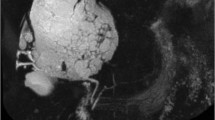Abstract
In Greece, which has the second highest incidence of echinococcosis in the world, there has been an overall decrease in the frequency of this disease and its complications during the past 15 years. Between 1920 and 1960, approximately 46 patients per year were operated on for echinococcosis at the Hellenic Red Cross Hospital, and 1.8% of 1037 hepatic hydatid cysts had ruptured into the bronchi. From 1960 to 1975, the number of patients requiring operation decreased to approximately 25 per year, and the incidence of rupture into the bronchi declined to 1% of 288 liver cysts. The reduction has resulted from improvements in preventive medicine and surgical care and a decrease in the frequency of infected cysts.
Bronchobiliary fistula is a serious complication of hydatid cyst of the liver and it must be treated surgically. A right thoracotomy or thoracoabdominal approach offers the possibility of dealing simultaneously with the hepatic cyst and the pulmonary lesions. The choice of operation depends on the findings and ranges from simple drainage of the hepatic cavity with division of the bronchobiliary communication, to resection of the lung (usually lobectomy) when a chronically infected pulmonary cavity is present. If a hydatid cyst of the liver ruptures simultaneously into the lung and the extrahepatic biliary tree with resultant obstruction of the common bile duct, unblocking of the common duct by evacuation of cysts and debris through a laparotomy takes priority over any other surgical action. Of 3 patients with bronchobiliary fistulas treated during the past 15 years, 2 were cured by simple drainage through a transabdominal approach.
Résumé
La Grèce, qui se classe seconde dans le monde quant à l'incidence de l'echinococcose, a vu diminuer durant les 15 dernières années, la fréquence et les complications de cette maladie. Entre 1920 et 1960, on a opéré à l'HÔpital de la Croix Rouge Héllénique environ 46 patients par année pour echinococcose, et 1.8% de ces 1,037 kystes hydatiques du foie étaient rompus dans le système bronchique. Entre 1960 et 1975 le nombre de patients nécessitant un traitement chirurgical a été réduit à environ 25 par année, et 1% seulement de ces 288 kystes hydatiques avaient fistulisé dans les bronches. Cette amélioration est dûe aux progrès realisés en médecine préventive et dans les soins chirurgicaux, et aussi en raison du nombre réduit de kystes infectés. La fistule broncho-biliaire est une complication grave de la maladie hydatique du foie et commande un traitement chirurgical. La thoracotomie droite ou l'incision thoraco-abdominale permettent d'accéder à la fois au kyste hépatique et aux lésions pulmonaires. Le choix de l'opération dépend de la pathologie rencontrée à l'exploration, et va du drainage simple de la cavité hépatique avec fermeture de la communication broncho-biliaire, à la résection pulmonaire (habituellement lobectomie) lorsqu'il s'agit d'un abcès pulmonaire chronique. Lorsqu'un kyste hydatique du foie se rompt simultanément dans le poumon et les voies biliaires extra-hépatiques, le traitement de l'obstruction cholédocienne par exploration chirurgicale devient impératif et doit avoir priorité sur toute autre action chirurgicale. L'article rapporte 3 cas de fistules broncho-biliaires traités durant les 15 dernières années; deux d'entre eux furent guéris par laparotomie et drainage simple.
Similar content being viewed by others
References
Dew, H.R.: Hydatid Disease. Its Pathology, Diagnosis and Treatment. Sydney, Australian Medical Publishing Co., Ltd. 1928
Dévé, F.: L'ouverture des kystes hydatiques du foie dans le poumon et les bronches. Oran, Vème Congrès Annuel des Sciences Médicales, 1935
Kourias, B.: Modalités nouvelles du traitement chirurgical des kystes hydatiques du foie rompus dans les bronches. Mém. Acad. Chir.79(31,32):810, 1953
Kourias, B.: Bilobectomie dans un cas de kyste hydatique du foie rompu dans les bronches. Soc. Hell. Chir., May 4, 1953
Kourias, B.: Kystes hydatiques du foie ouverts dans le poumon et les bronches. Etat actuel du traitement chirurgical. Arch. Int. Hidatidosis16:215, 1957
Toole, H., Propatoridis, J., Pangalos, N.: Intrapulmonary rupture of hydatid cysts of the liver. Thorax8(4):274, 1953
Toole, H.: Treatment of severe cases of intrapulmonary rupture of hydatid cysts of the liver. Arch. Int. Hidatidosis16:235, 1957
Barrett, N.R., Thomas, D.: Pulmonary hydatid disease. Br. J. Surg.40:222, 1952
Imperati, L.: A propos de quatre cas de fistules hépato-bronchiques opérées. Arch. Int. Hidatidosis16:243, 1957
Yacoubian, H.D.: Thoracic problems associated with hydatid cyst of the dome of the liver. Surgery79(5):544, 1976
Author information
Authors and Affiliations
Rights and permissions
About this article
Cite this article
Tierris, E.J., Avgeropoulos, K., Kourtis, K. et al. Bronchobiliary fistula due to echinococcosis of the liver. World J. Surg. 1, 99–104 (1977). https://doi.org/10.1007/BF01654744
Issue Date:
DOI: https://doi.org/10.1007/BF01654744




